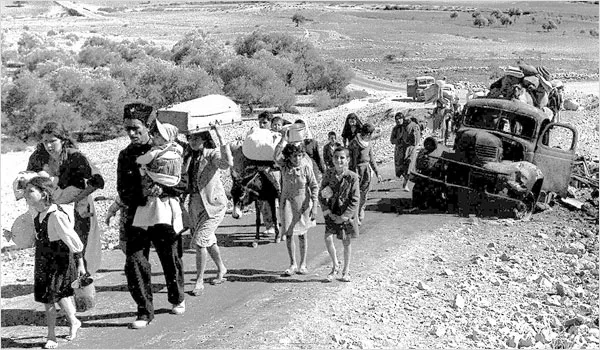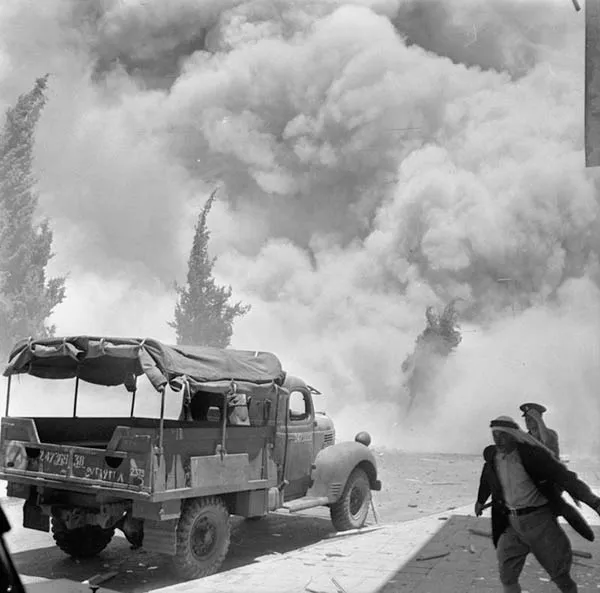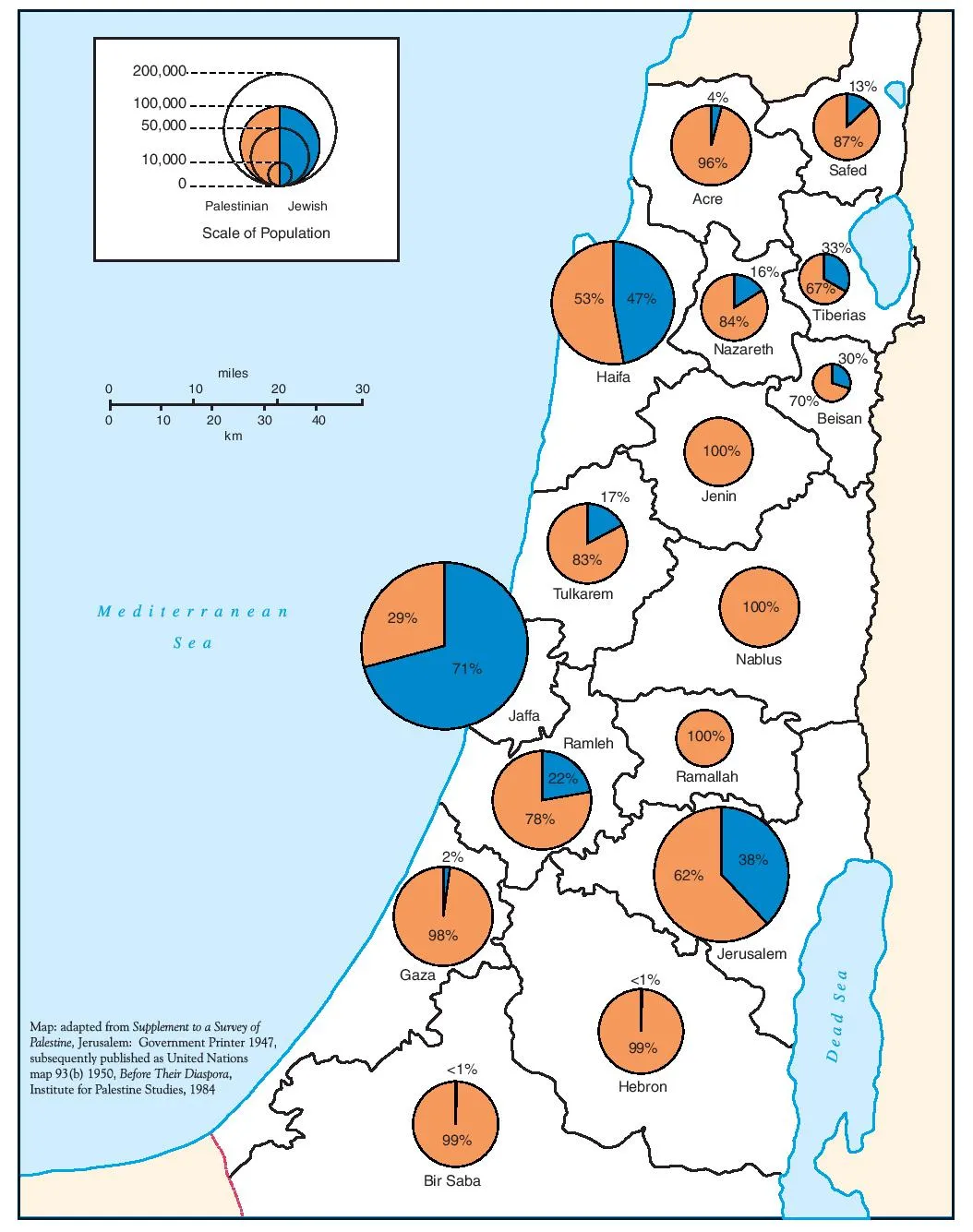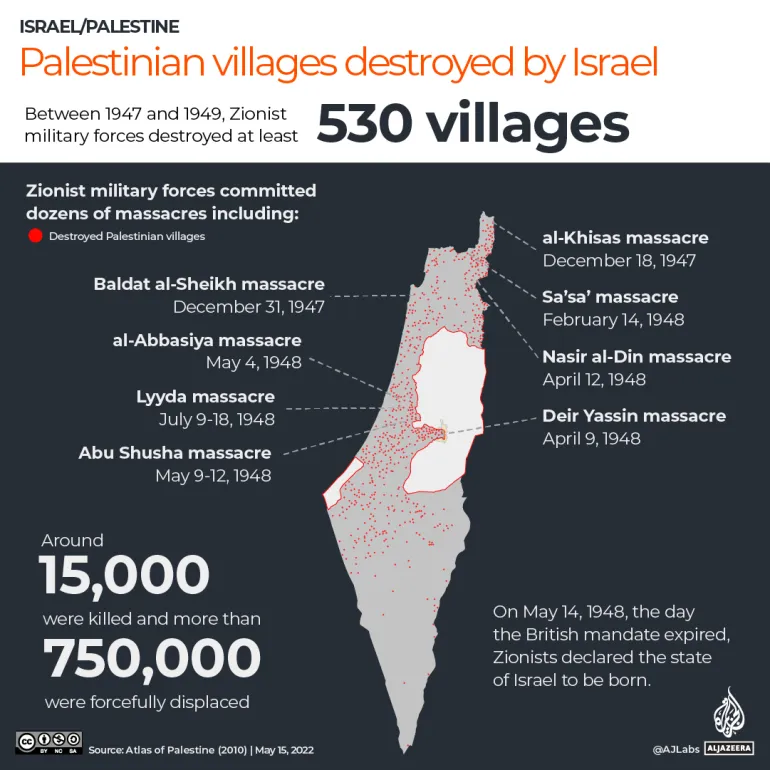Nakba of 1948
 1948: Palestinian refugees making their way from Galilee.
1948: Palestinian refugees making their way from Galilee.
The year 1948 marked a pivotal moment in Middle Eastern history with the Nakba (lit. catastrophe) and subsequent establishment of the Zionist state. The Nakba describes the mass violent expulsion of Palestinians from their homeland, a phenomenon often depicted in Zionist narratives as voluntary. However, Israeli historian Ilan Pappé, through meticulous historical analysis, debunks this narrative, illustrating how the exodus was neither voluntary nor incidental but a result of deliberate actions and policies. He states:
The Nakba is a pivotal and tragic event in the history of the Palestinian people, unfolded against the backdrop of the UN Partition Plan of 1947 and the subsequent Arab-Israeli conflict.
Rising Tensions and Conflict
Section titled “Rising Tensions and Conflict”Throughout the British mandate period, tensions escalated between the Jewish and Arab populations. The Holocaust and the subsequent influx of Jewish refugees to Palestine further intensified these tensions. Both Arab and Zionist groups expressed their discontent with British policies and actions, often through violent means.
Zionist resistance to British rule also intensified, especially after World War II. Jewish underground organizations, such as the Haganah, Irgun, and Lehi, conducted a series of attacks against British military and administrative targets.
One of the most notable terrorist attacks was the bombing of the King David Hotel in Jerusalem in 1946, an event that claimed the lives of 91 people and significantly damaged the British administrative headquarters.
 1946: The explosion of a bomb at the King David Hotel in Jerusalem by fighters of the Zionist ‘Irgun’ terrorist organisation.
1946: The explosion of a bomb at the King David Hotel in Jerusalem by fighters of the Zionist ‘Irgun’ terrorist organisation.
Faced with unrelenting violence, economic strain, and diplomatic pressure, Britain announced its intention to terminate the Mandate and withdraw from Palestine. This decision was formalized in 1947 when Britain referred the Palestine question to the United Nations, leading to the proposal of the 1947 Partition Plan and the subsequent end of the British Mandate in 1948.
The UN Partition Plan and Its Implications
Section titled “The UN Partition Plan and Its Implications”In 1947, the United Nations proposed a partition plan for Palestine. The plan was controversial, it sought to create two separate states: one Zionist and one Arab. The native Arab population did not recognise that the UN had a mandate to divide Palestine. The UN proposed an allocation 56% of the territory to the future Zionist state, despite the fact that the Jewish population constituted only one-third of the total population and ony owned a 11% of the land. In stark contrast, the Palestinian Arabs, who owned approximately 80% of this land and comprised approximately 66% of the population, were allocated only 44% of the land. The land designated for the Zionist state was predominantly owned by Palestinian Arabs. The clear disparity laid the groundwork for the ensuing turmoil.
 1948: Palestinian Population.
1948: Palestinian Population.
Operation Dalet
Section titled “Operation Dalet”The period from 1947 to 1949 was marked by a series of conflicts, often collectively referred to as the 1947-1949 Palestine war. The war was brought about due to conflicts between the native poulation, During and after these conflicts, hundreds of Palestinian towns and villages were systematically depopulated and destroyed.
Central to the Zionist project was the concept of ‘transfer’ - the idea of relocating the Palestinian population to pave the way for an exclusive Jewish state. The Zionist leadership, including figures like David Ben-Gurion, viewed the presence of a large Arab population as incompatible with their vision. Pappé references works like Nur Masalha’s “Expulsion of the Palestinians” to highlight how the transfer idea was deeply embedded in Zionist thought, not just as a tactical move but as an ideological imperative.
The forced expulsion of the native population formed part of a deliberate plan by the Zionist leaders called to as Operation Dalet or Plan D executed implemented by Zionist forces in April 1948. The military strategy aimed at securing territories for the new Jewish state led to the forceful expulsion of Palestinians from major cities and hundreds of villages. The operation was characterized by tactics that ranged from psychological warfare to direct military assaults, resulting in the depopulation and destruction of numerous Palestinian communities. Key Palestinian cities like Haifa, Jaffa, and Jerusalem witnessed large-scale expulsions. In Haifa, for instance, a combination of military attacks and psychological tactics induced a mass departure of its Arab population.
The plan included the following provided clear evidence to the genocidal methods to be employed to ethnically cleansing the Palestinian population:
Destruction of villages (setting fire to, blowing up, and planting mines in the debris), especially those population centers which are difficult to control continuously … Mounting search and control operations according to the following guidelines: encirclement of the village and conducting a search inside it. In the event of resistance, the armed force must be destroyed and the population must be expelled outside the borders of the state.2
Deir Yassin and other massacres
Section titled “Deir Yassin and other massacres”On April 9, 1948, Zionist forces committed one of the most infamous massacres of the war in the village of Deir Yassin on the western outskirts of Jerusalem. More than 110 men, women and children were killed by members of the pre-Israeli-state Irgun and Stern Gang Zionist militias.
By 1949, at least 750,000 Palestinians in total were expelled or fled outside of their homeland. Some 150,000 Palestinians remained in the areas of Palestine that became part of the Israeli state. Of the 150,000, over 30,000 were internally displaced. Like the 750,000 who were displaced beyond the borders of the new state, Israel also prohibited internally displaced Palestinians from returning to their homes.
 1947: Destruction of Palestinian Villages.
1947: Destruction of Palestinian Villages.
Cultural Genocide
Section titled “Cultural Genocide”The Nakba also saw a concerted effort to erase and replace the geographic and cultural heritage of Palestine. Palestinian place names were systematically removed and replaced with Hebrew names. In some cases, these new names were derivatives of the historical Palestinian nomenclature, while in others, they were entirely new inventions. This renaming process was part of a broader strategy to establish a new national identity for the state of Israel.
Moreover, the destruction extended beyond mere geography. Historical sites, particularly those significant to the non-Jewish population, were targeted. Over 80% of Palestinian village mosques were destroyed. Artifacts and historical documents were removed from museums and archives, further erasing the physical evidence of Palestinian heritage.
